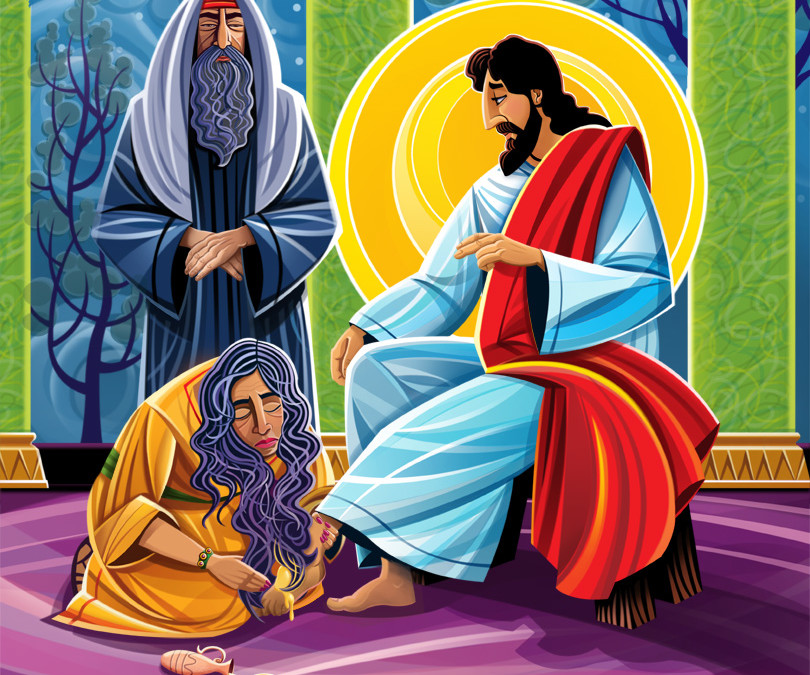Guess Who’s Coming to Dinner?
Have you ever attended one of those dinners where people are invited without knowing who the other guests will be? The idea is to make new acquaintances and enjoy an evening of pleasant surprises. These dinners are fun.
Usually.
Sometimes they offer more surprises than people were expecting. Maybe one of the guests forces boisterous opinions, behaves inappropriately, or has arrived in a condition that threatens the night’s pleasantries. We had one of these dinners where the couple bringing the salad showed up many hours late, with a bag of fast food salads, and they obviously had a heated argument on their way to our house. It was an awkward evening.
She’s Coming to Dinner?
Jesus was invited to a lot of dinners. This wasn’t unusual. Traveling Rabbis were often invited to dinner, and invited to share a word, opinion, or teaching about some subject. This was a kind of test, and if they satisfied the religious leaders that their views were sound, the dinner would proceed in normal fashion with interesting discussion.
Jesus endured a number of these tests. Sometimes while visiting homes, odd events forced the questions “who is he, and what is he up to?” or, “who does he think he is?” The scene I illustrated above depicts such an event.
One of the Pharisees asked Jesus to dine with him. While reclining at the table, a “woman of the city, who was a sinner” began to wet Jesus’ feet with her tears, wipe them with her hair, and anoint them with ointment from an alabaster flask. I think this was no less weird then than it would be today. It was turning into an awkward evening.
If the Pharisee intended to give Jesus one of those impromptu tests, then no better exam could have fallen into his hands. How would Jesus react to “this sinner, this woman of the city”?
In the eyes of his examiner, Jesus failed: “If this man were a prophet, he would have known who and what sort of woman this is who is touching him, for she is a sinner.” Read skank.
Luke, ever a stickler for details, had already slanted the story so that we might get a feel for the disdain “good people” have for “bad people”. He described her as a “woman of the city, who was a sinner”. Identifying her as a “woman of the city” might simply mean she was a local resident, but I wonder if it meant she was a woman of some considerable reputation in that city. Or if Luke meant to imply that she was an urbanite, and therefore particularly jaded.
There is a common idea among some “good people” that cities are more evil than the pastoral countryside. I’ll go on record as saying that’s bunk. There may be less crime in the country or small towns, but there isn’t less sin.
Testing, Testing.
There is no doubt what the Pharisee thought. This filthy tramp, this woman, was touching a rabbi, a religious teacher, maybe even a prophet.
If Jesus were such a big deal prophet, he would know “what kind of woman” was blubbering all over his feet, so the Pharisee gave Jesus an F.
Jesus gave the Pharisee an alternative test, in the form of a little story about an un-payable debt and gratitude for its cancellation: “Who loves the merciful moneylender more, the one who had a small debt forgiven, or the one burdened with the larger”?
“The one, I suppose, for whom he cancelled the larger debt.” answered the Pharisee.
“I suppose“?!
I can’t say for sure if Luke intended it, but that sounds like a begrudged concession. I don’t think there was any “I suppose” about it. Obviously the greater forgiveness would be much more appreciated.
Jesus assured the Pharisee that he “judged rightly”, but the Pharisee didn’t pass with flying colors.
Common decency required providing water to wash dusty feet that walked dirt roads. This judge of all things lawful and decent neglected providing this small amenity for his guest who was known to be an esteemed religious teacher, and maybe even a prophet.
A Tale of Two Sinners
My friend Malia commissioned two religious pictures for her husband Mike, subject of my choice. Themes of darkness and light, sin and forgiveness, self-righteousness and Jesus’ righteousness, factor into my image making.
I set the scene at night so that I could have fun with a current sky style that I’ve been playing with, using those circular shapes. No significance to them except that I think they look cool.
There are however some very intentional things going on in other places.
The night sky is invaded by considerable light, with its crescent moon and stars. Light overpowers darkness, darkness cannot overpower light. The huge yellow glow behind Jesus may be coming from an unseen lamp, but it suggests a halo. In my tradition halos aren’t used very often, but this circle serves double duty. It shines a light on the scene, and highlights that Jesus is the Light of the World.
What I had fun with (here’s the whimsy) was the beard on the Pharisee and the hair on the woman. Look and you’ll see they are handled in a similar way: swirly, chaotic, straggly, wild. I intended to show by shared hair that the woman and the Pharisee were both sinners. The only difference is that she knew it.
That’s a big difference. She wept onto Jesus’ filthy feet and loved him for forgiving her filthy soul. The Pharisee looked at her filthy head in disgust. Her warm yellow dress shows her basking in the Light of the World, while the same light exposes the Pharisee’s guilt. Basking in his own righteousness he remains in the dark, unaware how much he shares with this woman.
Where’s the Whimsy?
Like the story of the Prodigal Son that I wrote about a few weeks ago, with its companion piece to this art, there is a common theme of forgiveness. Neither of these stories are intended to be knee-slappers. Putting them in the category of whimsy is a challenge.
When I make images like this, drawing on my career as an artist for children’s books and materials, I’m going with my natural bent for bright, playful, graphic imagery. It’s how I’m wired and I learned a long time ago to go with it. My definition of whimsy is”playfully quaint or fanciful”. This was Webster’s primary definition.
It’s not at all funny, or playfully quaint, for a Pharisee to remain shrouded in his own dark self-satisfaction. When I’m in Pharisee mode, cloaked in self-righteous disgust for those I think are beneath me, those are my worst, and least whimsical, moments.
When light is shined upon my filthy head, and the radiance of Jesus’ light restores my sight, then I remember that while I was still a sinner, Christ died for me. Not after I stopped being a sinner, and cleaned myself up. Not after I got “more religious”, but while I was a sinner. That’s what Jesus did, he came into the world to save sinners.
That’s bright, colorful, and in my mind, whimsical, because it’s upside down, inside out, and over the top.
The story about this woman is in Luke’s Gospel, chapter 7:36-50. The reference above is Romans 5:8
Forgiven ©2016 Ed Koehler

